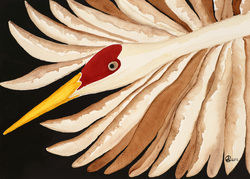
I watched a YouTube Video yesterday of the influx of Sandhill Cranes to the Platte River Valley. The most impressive part of the video was the audio; what a cacophony of trumpeting and cackle as thousands of birds were communicating with each other. My interest was sparked and I went on to read a number of posts on the internet that I will be checking out over the next few weeks. One very disturbing post talks about farmers wanting to further genetically modify corn to make it so that when the crane eats one bite of corn, they will never eat corn again. This is pretty scary. However after researching this a little further, it turns out the International Crane Foundation (ICF) is behind it and they explain it this way.
Though Sandhill Crane populations in the northern boreal forest and arctic have likely been stable for a decade or more, Sandhill Crane populations in temperate regions of the U.S. and Canada have been expanding rapidly. This wildlife success story is possible because a recovering crane population has found available wetlands to nest in and agricultural lands that are suitable for foraging. The positive relationship between crane and farmer is precarious and currently is threatened by growing amounts of crop damage caused by cranes. To help re-establish a more positive relationship between cranes and the landowners who provide habitat, ICF is helping to develop a new technique to treat corn seeds with a deterrent before the seeds are planted. In response, foraging Sandhills avoid treated seed but remain in the field to feed
non-destructively on other foods. ICF is currently collaborating with partners to make this technique available to farmers throughout the Midwest. Of equal importance is our ability to monitor crane populations for new problems that may arise. To this end, ICF sponsors the Annual Midwest Crane Count through which thousands of volunteers count cranes each April. Measuring the increase or decrease of crane populations is a critical step in fine-tuning management plans for any species. To learn more about the Annual
Midwest Crane Count, click here.
With 85% of all corn being genetically modified in one way or another, AND the fact that we do not know how it is affecting all life forms, I have to say that this further modification does not WOW me. But it appears to be a trade-off and certainly remains to be seen.
Then here is a link to an article about Bosque del Apache National Wildlife Refuge, part of the National Wildlife Refuge System, that is planting heirloom, Aztec corn specifically for the Sandhill cranes. The project’s long–term goal is: to grow enough Aztec corn seed to feed the refuge’s own birds—primarily Sandhill cranes, to supply surplus corn to other refuges and to do both with minimal environmental disturbance. This is a lot more to my liking. :-)
http://www.fws.gov/refuges/RefugeUpdate/MarApr_2012/hardycorn.html
And here is the link to the YouTube video to hear/see the cranes arriving at the Platte River.
http://www.bing.com/videos/search?q=sandhill+crane+video&mid=59D85D101542130C2F9759D85D101542130C2F97&view=detail&FORM=VIRE3
Though Sandhill Crane populations in the northern boreal forest and arctic have likely been stable for a decade or more, Sandhill Crane populations in temperate regions of the U.S. and Canada have been expanding rapidly. This wildlife success story is possible because a recovering crane population has found available wetlands to nest in and agricultural lands that are suitable for foraging. The positive relationship between crane and farmer is precarious and currently is threatened by growing amounts of crop damage caused by cranes. To help re-establish a more positive relationship between cranes and the landowners who provide habitat, ICF is helping to develop a new technique to treat corn seeds with a deterrent before the seeds are planted. In response, foraging Sandhills avoid treated seed but remain in the field to feed
non-destructively on other foods. ICF is currently collaborating with partners to make this technique available to farmers throughout the Midwest. Of equal importance is our ability to monitor crane populations for new problems that may arise. To this end, ICF sponsors the Annual Midwest Crane Count through which thousands of volunteers count cranes each April. Measuring the increase or decrease of crane populations is a critical step in fine-tuning management plans for any species. To learn more about the Annual
Midwest Crane Count, click here.
With 85% of all corn being genetically modified in one way or another, AND the fact that we do not know how it is affecting all life forms, I have to say that this further modification does not WOW me. But it appears to be a trade-off and certainly remains to be seen.
Then here is a link to an article about Bosque del Apache National Wildlife Refuge, part of the National Wildlife Refuge System, that is planting heirloom, Aztec corn specifically for the Sandhill cranes. The project’s long–term goal is: to grow enough Aztec corn seed to feed the refuge’s own birds—primarily Sandhill cranes, to supply surplus corn to other refuges and to do both with minimal environmental disturbance. This is a lot more to my liking. :-)
http://www.fws.gov/refuges/RefugeUpdate/MarApr_2012/hardycorn.html
And here is the link to the YouTube video to hear/see the cranes arriving at the Platte River.
http://www.bing.com/videos/search?q=sandhill+crane+video&mid=59D85D101542130C2F9759D85D101542130C2F97&view=detail&FORM=VIRE3

 RSS Feed
RSS Feed
